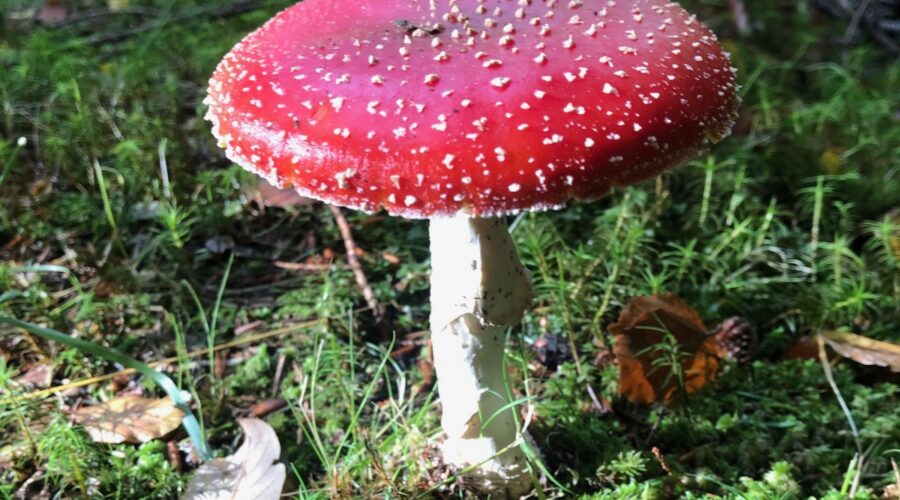If there is one silver lining to the pandemic, it is the time it has presented me to read. As I dialed down the year and began preparing myself for the uncertainties of the next, I turned to the last on my list: a book on fungi. Picking up Entangled Life: How Fungi Make Our Worlds, Change Our Minds and Shape Our Futures, by mycologist Merlin Sheldrake, I was curious to learn, but also somewhat skeptical. Knowing next to nothing about fungi (except that they are delicious on pizza), I wondered if the book would convince me of its ambitious title. It did that, and a little more. While I did go on to learn plenty about fungi, I did not expect to be intrigued, inspired, and dare I say, hopeful.
Fungi have left me questioning our understanding of relationships between organisms. They have lured me into dabbling in fermenting and brewing in my kitchen. Less than a book review or summary, this article is a personal meditation on how the lessons on fungi have made me rethink the lenses with which I approach my work in land use, forestry, and climate policy.
Fungi occupy a kingdom of their own
Mushrooms tend to be what comes to mind when we think of the word fungi. These caps that magically appear overnight, however, are just the visible fruiting bodies of some fungal species, connected to a meshwork of cells below. Neither animal nor plant, fungi occupy a life kingdom of their own. Some species are single-celled, microscopic organisms (e.g., yeasts), while others are multicellular, extending long fibers that form expansive and dense networks called mycelium.
As they sprawl through their environment – whether it is in soil, on a log decomposing on the forest floor, or in the rising bread dough in your kitchen – they chemically (and sometimes, physically) break down complex compounds and decompose raw material into nutrients for itself and others. They possess what some scientists call “brainless intelligence”; fungi can navigate and find the shortest path in a labyrinth. When presented with food arranged to mimic Japanese cities around Tokyo, slime mold developed networks to transport this food which resembles the Tokyo railway system. Fungi are also resilient enough to withstand extreme environments, among them, outer space and one of the most radioactive sites on earth, Chornobyl.
Mycorrhizal networks are crucial for terrestrial flora
Unable to photosynthesize and fix carbon themselves, fungi tend to partner up with other organisms. Lichen is the textbook example, a marriage between fungi and algae that continues to challenge efforts to classify organisms and their relationships to each other within modern science. It was this symbiosis that, 500 million years ago, enabled algae to leave water and inhabit land, feeding off nutrients stored in rocks that were unpacked by fungi. This union is the predecessor of what we today know as plants.
Fungi continue to be integral to the lives of terrestrial flora. Whether a majestic oak or an unassuming shrub, 90 percent of plants continue to depend on mycorrhizal (myco = fungi, rhizal = root) networks for their everyday existence. Fungi can travel further than plant roots, scavenging key minerals such as phosphorous on behalf of their plant partners. Research finds that mycorrhizal networks connect trees to each other and coordinate the sharing of nutrients between plants, via the soil. Fungi do more than feed plants; they increase the volume of water absorbable by soil and reduce nutrient leaching, serving as what Sheldrake calls, “the sticky living seam that stitches soil together.” Their function in an ecosystem has earned them the title of keystone organisms or “ecosystem engineers.”
Fungi as the pioneers of carbon sinks
Fungi also are responsible for cooling down an inhabitable Earth. Scientists are discovering that the greening of the biosphere during the Paleozoic era, which sequestered large amounts of carbon dioxide, would not have been possible without fungi. By incorporating data on mycorrhizal fungi in climate models, scientists have found that the amount of oxygen and carbon dioxide in the atmosphere varied according to the efficiency of mycorrhizal exchange. Mycorrhizal fungi influenced how much carbon dioxide plants could absorb, by mediating the number of phosphorous plants had access to, and could therefore grow. Fungi are believed to have served as a carbon sink in another significant way; they break into solid rock and harvest minerals like calcium and silica, which react with carbon dioxide to produce new compounds – carbonates and silicates. These find their way into the ocean and are utilized by marine organisms to make shells.
Let us consider what lies below the surface
As an organism that has witnessed and survived multiple transformations of the planet, fungi have much to teach us as we reel into another, this time anthropogenically-induced, planetary shift. For someone whose day-to-day is thinking about how can we better protect and restore remaining forests, the lessons on fungi compel me to pause. When we think of forests, what comes to mind? Tall, towering barks. Canopies of green, dotted with the blue of the sky. Less often does the mind’s eye consider what is below.
The dominant perspective tends to simplify and reduce complex forest systems to their individual parts; the trees they contain, the land area they span, or the quantity of carbon their trees sequester. With advanced satellite technology, we can now characterize forests by their level of tree cover.
Don’t get me wrong. The methodological and technological advances we have made in these fields are incredibly valuable and necessary for science and policy to continuously improve. We know forests are complex ecosystems, responsible for a host of biophysical processes necessary for life, and are home to biodiverse organisms. Yet these advancements have focused primarily on the parts of forests that are more immediately visible and measurable. Trees, as beautiful and important as they are, become a proxy for the larger whole.
A new perspective: Forests are more than the sum of their individual parts
Personally, learning about mycorrhizal fungi reminds me there is more to forests than meets the eye, and we are still learning about their complexity. Bringing our attention to what is happening below the surface of forests is a refreshing, and necessary, shift in perspective. Paying attention to the life processes under the surface might help us move away from a narrow, essentialist perspective of forests to a broader, more encompassing view.
A holistic view recognizes that forests are not just a sum of their individual parts. Such a perspective values, prioritizes, and fights to conserve existing natural ecosystems in their entirety. It means that offsetting or compensating for the destruction of primary old-growth forests is simply unacceptable. It means strengthening and enforcing the rights of Indigenous peoples and local communities that have been stewards of forests for time immemorial. It means to embrace and include different sources of knowledge and views on the natural world and our role in it.
In our efforts to protect, restore, and rehabilitate forests, I wonder if we are called to seek inspiration from our microscopic counterparts. Might fungi that serve as ecosystem engineers have some lessons for us? How could we as humans think of ourselves as ecosystem engineers? What would our relationship to the natural world look like? What would it take?
What will our relationship with land be as we move forward?
Ecologist and botanist Robin Wall Kimmerer sketches some possible visions, in her book Braiding Sweetgrass: Indigenous Wisdom, Scientific Knowledge and the Teachings of Plants. She suggests that as we seek to protect and restore natural ecosystems, we need to ask what will our relationship with land be as we move forward. In Indigenous worldviews, a healthy landscape is one that is whole and generous enough to sustain its partners. Just as fungi’s role as an ecosystem engineer is based on partnership with trees and other organisms, how would our relationship with ecosystems change if we understood them as a partner, rather than a resource?
The lessons of fungi leave me humbled. Our knowledge and understanding of this entire species is nascent; we have much to learn about and from them. I am reminded of a saying by Avvaiyar, a female Tamil, poet from 4th century BCE,
“கற்றது கைமண் அளவு, கல்லாதது உலகளவு” | “Katrathu Kai Mann Alavu, Kallaathathu Ulagalavu“
“What we have learned, is like a handful of earth; what we have yet to learn, is like the whole world”
There is a whole world right under our feet.


